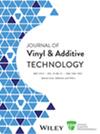Modification of chain extension and crosslinking structures of recycled polyester textile for 3D printing filament
Abstract
The increase in amount of polyester textile waste is contributing to the severity of environmental pollution because polyester cannot be easily recycled. To reduce the limits of its recyclability, a value-added recycling approach should be explored. This work introduces an approach for recycling polyester textiles into 3D printable filaments. To increase recyclability of polyester textiles, the polyester materials are modified by ADR4468 additive. After the polyester is 3D printed, the sample with 1.0 wt% of ADR4468 shows the highest tensile and compressive strength properties compared with 1.5 and 2.0 wt%, owing to its fewer voids between the printed lines, a fish scale-like morphology that spreads out, and a higher degree of crystallization. Moreover, the mechanism of modification suggests that ADR4468 extends and crosslinks the polyester chains by ring-opening reactions of epoxy groups of ADR4468 and forms sea-island structures. The sea-island structures of bonded polyester branched cores with tangled polyester shell interface areas and unbonded polyester chain areas performed suitable rheological behaviors to recycle polyester textiles for 3D printable filaments production. The filaments can be used to replace commercially available filaments, offer a sustainable option for consumers, and impact both the polyester textile-related recycling and 3D printing industries.
Highlights
- An approach is proposed to recycle polyester textiles for 3D printing filament
- The approach uses a mechanical method to recycle polyester textiles
- Recycled polyesters were modified by ADR4468 to form core-shell structures
- Core-shell structures were separated by short polyesters(sea-island structure)
- The structures met rheological behaviors for 3D printing filament


 求助内容:
求助内容: 应助结果提醒方式:
应助结果提醒方式:


